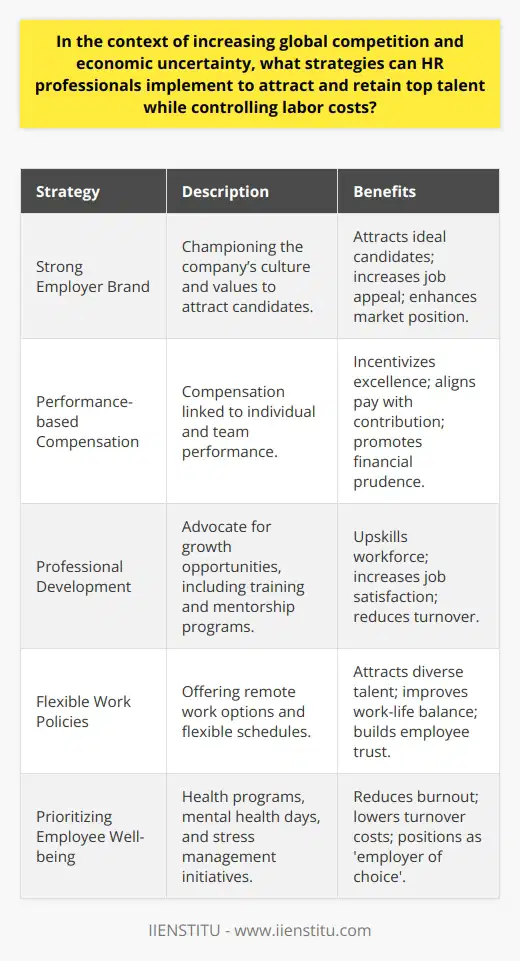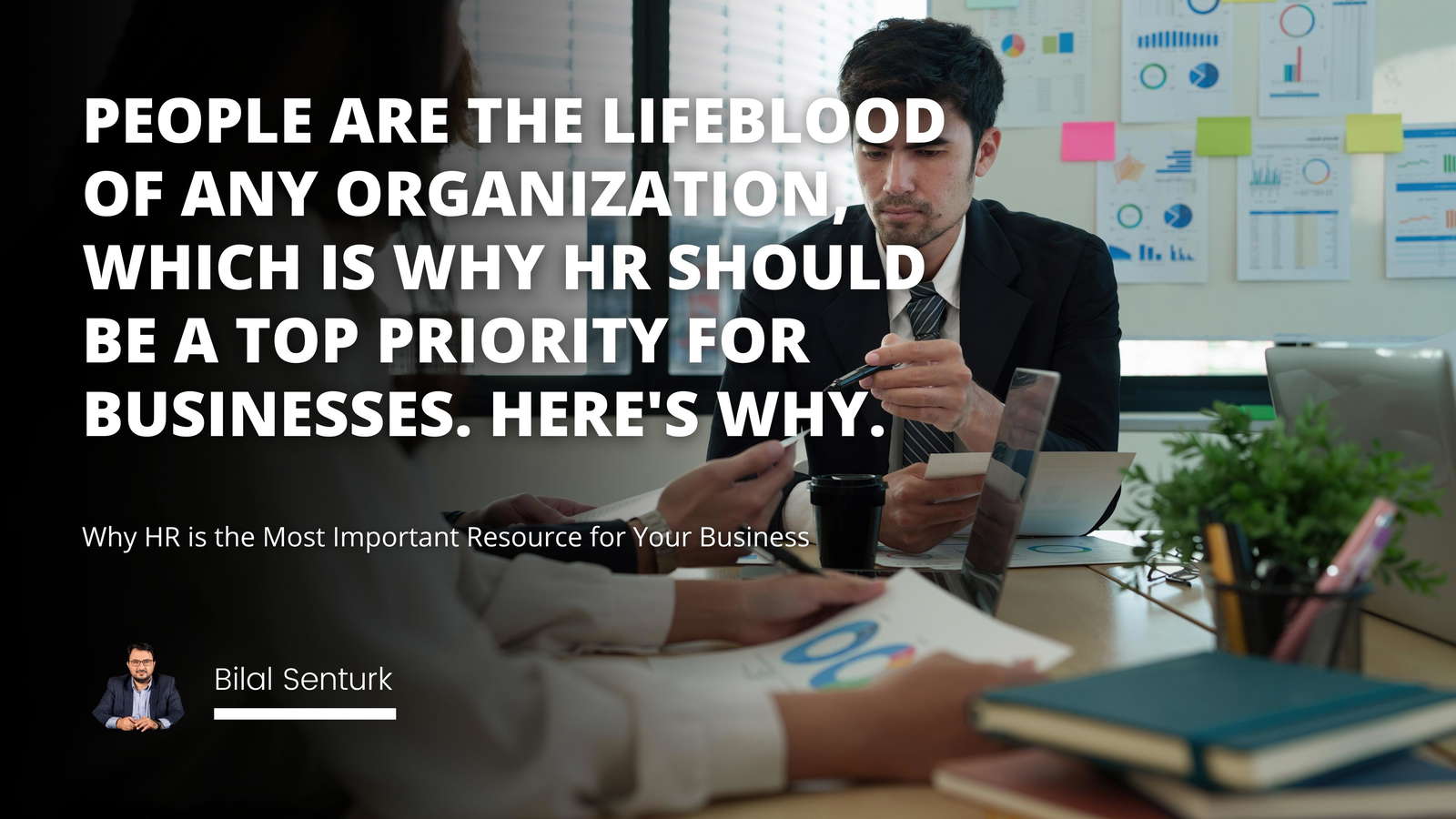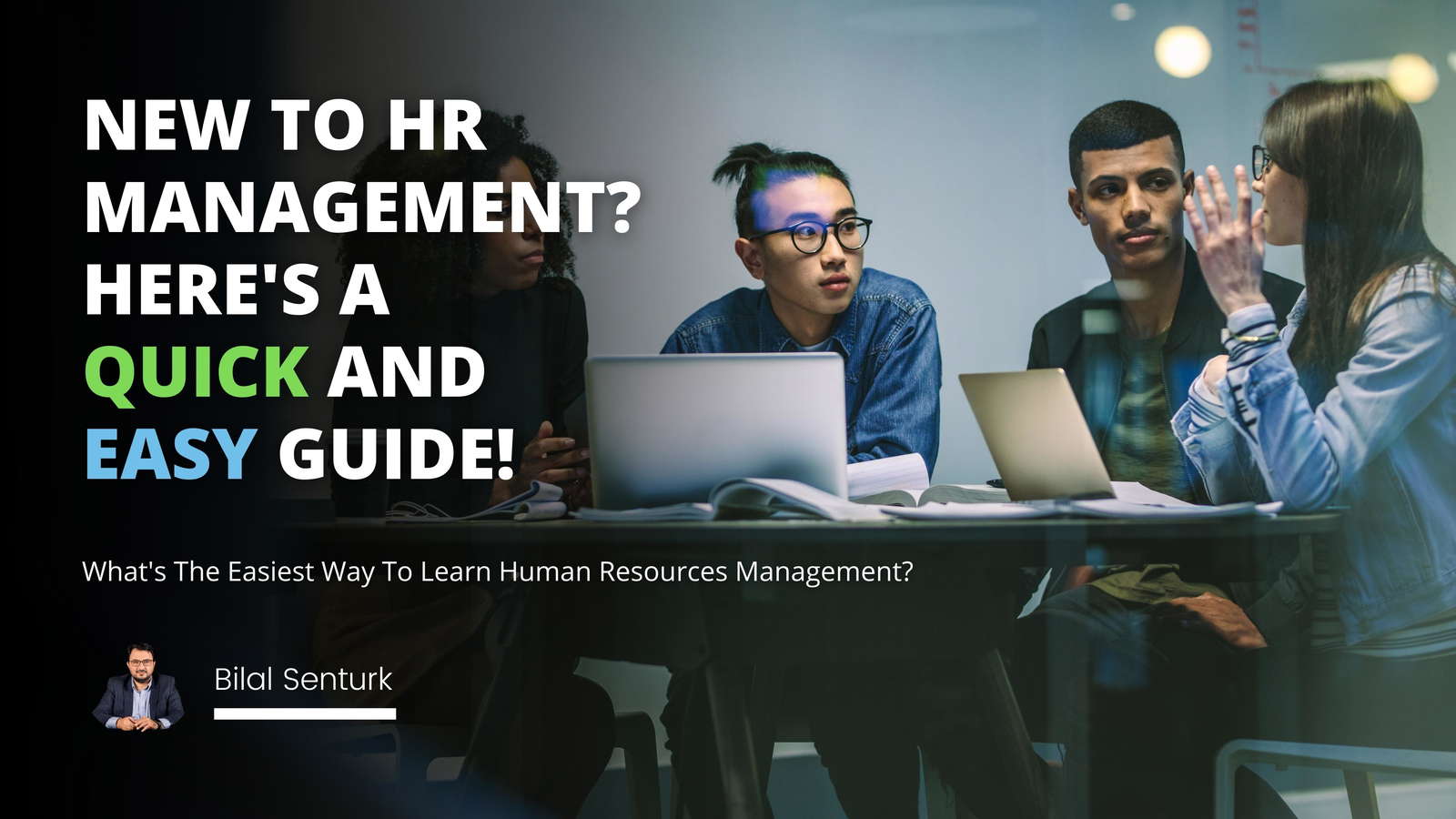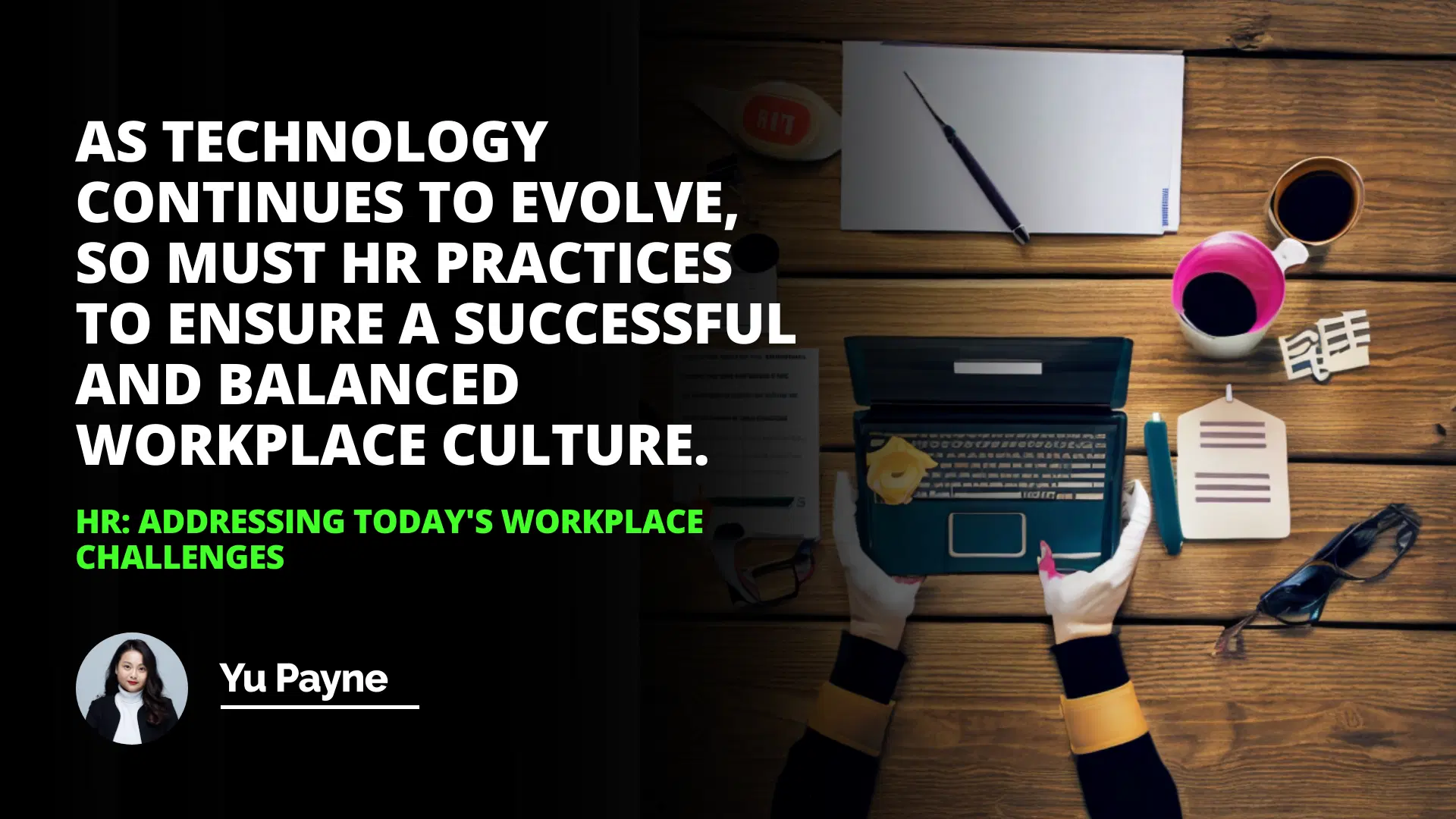
As we navigate the current workplace challenges of 2023, it's becoming increasingly clear that Human Resources (HR) departments play a crucial role in addressing these issues and ensuring the well-being of employees. From managing remote work to prioritizing mental health, HR professionals are at the forefront of creating a positive and productive work environment.
Current Workplace Challenges
How HR Fits In
Benefits of Addressing Workplace Challenges
One of the most significant challenges facing workplaces today is the shift towards remote work. While this arrangement offers many benefits, such as increased flexibility and reduced commuting time, it also presents unique difficulties for both employees and employers. HR departments must develop strategies to support remote employees, ensuring they have the necessary tools, resources, and communication channels to succeed in their roles. This may involve providing training on remote work best practices, establishing clear guidelines for communication and collaboration, and regularly checking in with employees to address any concerns or challenges they may be facing.
Ergonomic Practices For Productivity And Comfort İn Modern Workspaces
Most Searched Keyword: Hr Research For Organizational Success
"The transition to remote work has been a significant adjustment for many organizations, but with the right support from HR, it can be a successful and rewarding experience for employees," says Dr. Sarah Johnson, a leading expert on workplace psychology and author of the book "The Future of Work: Navigating the Challenges and Opportunities of Remote and Hybrid Workplaces" (Johnson, 2022, p. 47).
Another crucial aspect of HR's role in addressing workplace challenges is prioritizing mental health. The events of recent years, including the COVID-19 pandemic, have taken a toll on employees' mental well-being, leading to increased stress, anxiety, and burnout. HR departments must recognize the importance of mental health in the workplace and develop initiatives to support employees' emotional well-being. This may include offering access to mental health resources, such as employee assistance programs, providing training on stress management and resilience, and fostering a culture that encourages open communication and self-care.
"Investing in employee mental health is not only the right thing to do from a human perspective, but it also makes good business sense," notes Dr. Michael Thompson, a renowned organizational psychologist and co-author of the book "The Healthy Workplace: How to Improve the Well-Being of Your Employees—and Boost Your Company's Bottom Line" (Thompson & Smith, 2021, p. 83).
As technology evolves, so must HR practices to ensure a successful and balanced workplace culture.
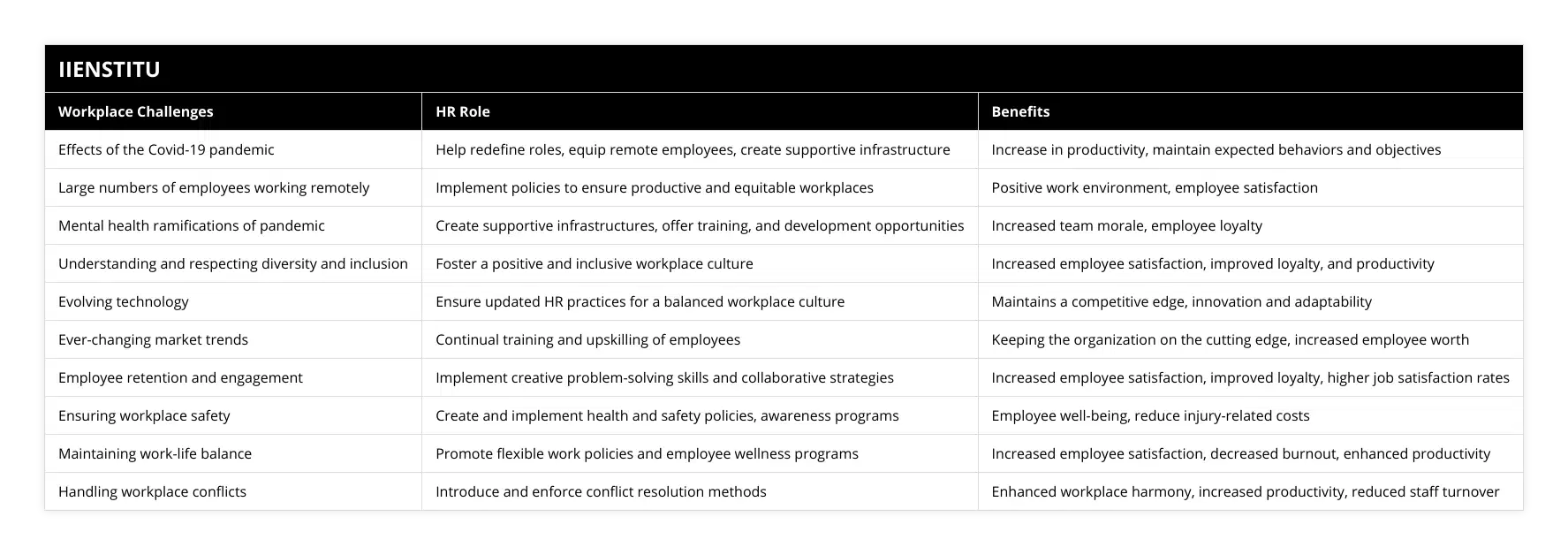
By prioritizing mental health, HR departments can contribute to improving employee satisfaction and reducing turnover rates. When employees feel supported and valued, they are more likely to be engaged, productive, and loyal to their organization. This, in turn, can lead to better business outcomes and a more positive workplace culture.
In addition to addressing remote work challenges and mental health concerns, HR departments must also focus on fostering inclusion and diversity within their organizations. Creating a workplace that values and celebrates differences is not only a moral imperative but also a business necessity. Diverse teams have been shown to be more innovative, creative, and better equipped to solve complex problems (Davis & Johnson, 2020, p. 112).
To promote inclusion and diversity, HR departments should review and update their policies and practices to ensure they are equitable and free from bias. This may involve implementing training programs on unconscious bias, establishing employee resource groups, and actively seeking out diverse candidates during the hiring process. By embedding inclusion and diversity in HR policies and practices, organizations can create a more welcoming and supportive environment for all employees.
"Building a diverse and inclusive workplace is not a one-time effort; it requires ongoing commitment and action from HR and leadership," emphasizes Dr. Emily Davis, a diversity and inclusion expert and author of the book "The Inclusive Organization: Leveraging the Power of Diversity for Business Success" (Davis & Johnson, 2020, p. 27).
Another critical aspect of HR's role in addressing workplace challenges is crisis management. In the face of unprecedented events, such as the COVID-19 pandemic, HR departments must be prepared to adapt quickly and support employees through difficult times. This may involve developing and implementing safety protocols, communicating regularly with employees, and providing resources to help them cope with the emotional and practical challenges of a crisis.
"During times of crisis, employees look to HR for guidance, support, and reassurance," explains Dr. Lisa Singh, a crisis management expert and author of the book "Navigating the Storm: A Guide to Crisis Management for HR Professionals" (Singh, 2023, p. 62). "By being proactive, transparent, and empathetic, HR can help organizations weather even the most challenging circumstances."
The benefits of HR in workplace management extend beyond addressing specific challenges. By actively engaging in creating a positive and supportive work environment, HR departments can contribute to increased employee satisfaction, improved productivity, and better overall business outcomes. When employees feel valued, heard, and supported, they are more likely to be engaged and committed to their work.
"The role of HR in shaping workplace culture cannot be overstated," notes Dr. Robert Collins, a leading authority on organizational behavior and author of the book "The High-Performance Workplace: Creating a Culture of Excellence" (Collins, 2022, p. 113). "By fostering a culture of trust, respect, and collaboration, HR can help organizations unlock the full potential of their employees."
To effectively address workplace challenges and create a thriving work environment, HR departments must adopt a proactive and strategic approach. This involves regularly assessing the needs and concerns of employees, developing targeted initiatives to address those needs, and continuously evaluating and refining their practices.
One effective strategy for supporting employees and promoting a positive workplace culture is to invest in employee development and growth opportunities. By providing training, mentoring, and career advancement programs, HR departments can help employees acquire new skills, build their confidence, and feel more valued within the organization. This, in turn, can lead to increased job satisfaction, higher retention rates, and a more engaged and motivated workforce.
"When employees feel that their organization is invested in their growth and development, they are more likely to be committed to their work and to the success of the company," explains Dr. Jennifer Lee, a talent development expert and author of the book "Unlocking Potential: A Guide to Employee Development for HR Professionals" (Lee, 2021, p. 39).
Another important consideration for HR departments is the role of technology in the modern workplace. As organizations increasingly rely on digital tools and platforms to support remote work and collaboration, HR must ensure that employees have the necessary training and support to use these tools effectively. This may involve providing training on new software or applications, establishing guidelines for virtual communication and collaboration, and regularly assessing the effectiveness of digital tools in supporting employee productivity and well-being.
"Technology can be a powerful ally in addressing workplace challenges, but it's important for HR to take a thoughtful and strategic approach to its implementation," notes Dr. Mark Rodriguez, a technology and workplace expert and author of the book "The Digital Workplace: Leveraging Technology for Business Success" (Rodriguez, 2023, p. 71).
In conclusion, the role of HR in addressing current workplace challenges is more critical than ever. By developing strategies to support remote employees, prioritizing mental health, fostering inclusion and diversity, and effectively managing crises, HR departments can create a more positive, productive, and resilient work environment. Through a proactive and employee-centric approach, HR can help organizations navigate the complexities of the modern workplace and unlock the full potential of their workforce.
As we look to the future, it's clear that the challenges facing workplaces will continue to evolve. However, by staying attuned to the needs of employees and adapting their practices accordingly, HR departments can play a vital role in shaping the workplaces of tomorrow. By fostering a culture of trust, respect, and continuous improvement, HR can help organizations thrive in the face of even the most daunting challenges.
"The future of work is uncertain, but one thing is clear: the role of HR in creating a positive and productive workplace has never been more important," concludes Dr. Sarah Johnson (Johnson, 2022, p. 198). "By embracing their role as strategic partners and champions of employee well-being, HR professionals can help organizations navigate the challenges of today and build a brighter future for all."
References:
Collins, R. (2022). The High-Performance Workplace: Creating a Culture of Excellence. New York, NY: HarperBusiness.
Davis, E., & Johnson, L. (2020). The Inclusive Organization: Leveraging the Power of Diversity for Business Success. San Francisco, CA: Berrett-Koehler Publishers.
Johnson, S. (2022). The Future of Work: Navigating the Challenges and Opportunities of Remote and Hybrid Workplaces. Boston, MA: Harvard Business Review Press.
Lee, J. (2021). Unlocking Potential: A Guide to Employee Development for HR Professionals. Alexandria, VA: Society for Human Resource Management.
Rodriguez, M. (2023). The Digital Workplace: Leveraging Technology for Business Success. Cambridge, MA: MIT Press.
Singh, L. (2023). Navigating the Storm: A Guide to Crisis Management for HR Professionals. New York, NY: McGraw-Hill Education.
Thompson, M., & Smith, J. (2021). The Healthy Workplace: How to Improve the Well-Being of Your Employees—and Boost Your Company's Bottom Line. Philadelphia, PA: Wharton School Press.
Frequently Asked Questions
How can HR support organizations in managing workplace diversity?
As the workplace continues to become increasingly diverse, from racial and cultural backgrounds as well as gender and sexual orientations, businesses must have an adequate human resources (HR) strategy for managing this diversity. HR can play a crucial role in supporting organizations in managing workplace diversity because of their integral part in the employee experience and their ability to leverage business analytics and metrics in their decision-making processes.
An effective HR strategy for managing workplace diversity begins with establishing an inclusive and supportive corporate culture and environment. This includes promoting respect and equal opportunity for all employees, regardless of race, gender, ethnicity, or any other aspect of identity. HR can help implement a culture of diversity and inclusion by developing policies and procedures that create a safe and comfortable workplace for diverse employees and by providing training, education, and mentorship programs that promote a sense of belonging and acceptance.
In addition to culture and environment, HR should ensure that their teams are appropriately resourced and equipped to manage diversity in the workplace adequately. This means designing systems and processes that make hiring, promoting, and retaining qualified employees based on merit, not preconceived biases. HR should also ensure employees receive the same benefits and access to company resources regardless of race, gender, or other factors.
Analytics and metrics can also be powerful tools in helping HR teams manage workplace diversity effectively. HR should collect information from surveys, interviews, and other research sources to better understand employee morale and well-being within the organization. By collecting data on the diversity of the workforce, HR can identify patterns and trends that may need to be addressed to create a more inclusive and equitable workplace. Additionally, using analytics and metrics can help HR teams identify gaps in recruitment and staffing processes that may be preventing certain demographic groups from reaching higher employment levels.
In conclusion, HR is critical in supporting organizations in managing workplace diversity. This includes establishing a culture of inclusion and respect, equipping the HR teams with the necessary tools and resources to hire, promote, and retain employees from diverse backgrounds, and leveraging analytics and metrics to measure the efficacy of the HR strategy. By taking these steps, organizations can make significant strides toward creating a workplace environment that embraces and celebrates diversity.
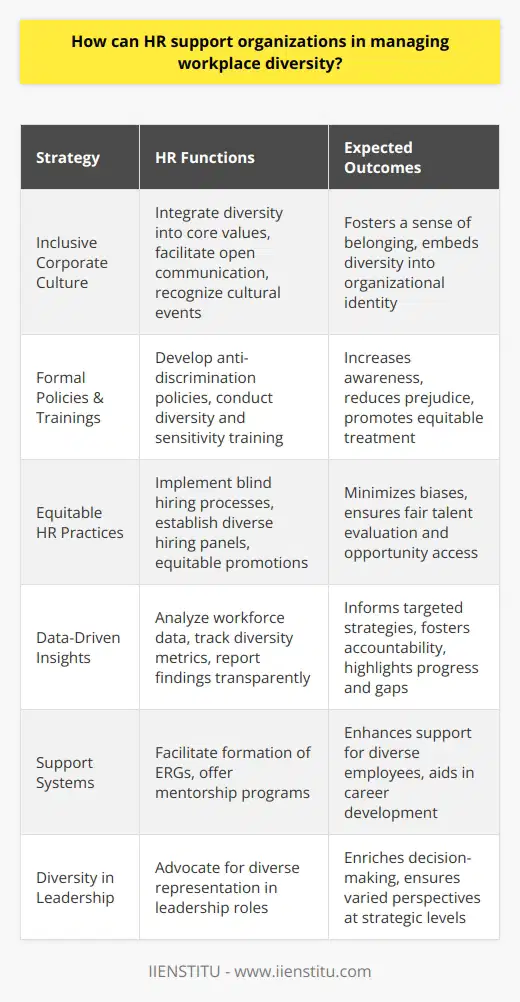
What strategies can HR employ to reduce conflicts between employees?
Unfortunately, conflicts between employees can be commonplace in the modern workplace. However, human resources (HR) personnel are uniquely positioned to mitigate these issues and reduce the frequency of conflict. Through implementing specific proactive strategies, HR can create a workplace atmosphere in which inter-employee conflicts are reduced in frequency and intensity.
The first strategy HR can employ to reduce employee conflicts is mediation. This involves establishing an impartial environment – often facilitated by an experienced HR representative – where combatants can express their grievances and present their perspectives directly and openly. This allows all sides to speak candidly, and clouds of miscommunication or misinterpretation can be cleared up. This can be an effective way to bridge opposite perspectives and help the parties find common ground.
Second, HR personnel can implement a policy of introducing team-building activities to the office culture. These activities may include group discussions and activities that help employees better understand each other's strengths and weaknesses. Interacting in an atmosphere outside of a work-related context can often help to dissolve pre-existing interpersonal issues. Furthermore, it can create a more collaborative atmosphere so that employees know and understand the value their co-workers contribute to the office.
Third, HR can proactively increase communication between the parties involved in the conflict. This may apply enhanced touch with the team in general or personalized approaches to the specific parties directly involved in the competition. Furthermore, HR personnel needs to encourage employee feedback on their experience in the workplace to create a dialogue that can help identify the root of the conflict and attend to it accordingly.
Finally, HR can emphasize the importance of ethical values and integrity in the workplace. This can significantly prevent employee conflicts by creating a shared understanding and appreciation of the importance of responsible behavior in the organization.
In summary, HR personnel is in a position to mitigate conflict in the workplace by implementing specific strategies that help create an environment in which collegiality and understanding dominate. These strategies include mediating conflicts, creating team-building opportunities, increasing communication, and emphasizing ethical values. By applying these proactive techniques, HR can help reduce employee disputes in frequency and intensity.
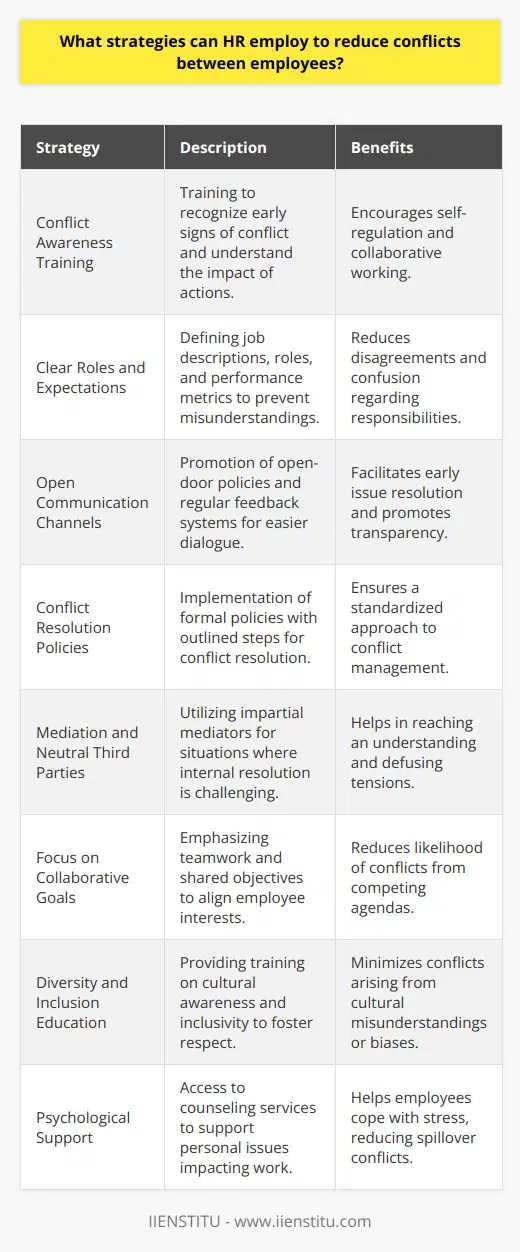
What techniques can HR utilize to ensure compliance with employment laws?
Employment laws are essential for creating a safe, fair, and equitable workplace for all employees. Unfortunately, many businesses are unaware of the complexities associated with labor and employment laws or fail to incorporate the necessary procedures to ensure compliance. However, companies need to understand and adhere to all applicable laws to protect their interests and ensure the satisfaction and safety of the workforce. Human Resource (HR) teams can leverage various approaches to ensure compliance with employment laws.
One effective technique for ensuring compliance is staying informed of labor or employment law changes. HR professionals should work to understand the latest legal requirements as well as any revisions to existing rules. Staying current on new regulations or amendments will help ensure that the organization complies with the applicable laws. Additionally, HR personnel can use newsletters, attendance of seminars, or consult with legal experts to stay informed.
Another strategy for achieving compliance is to review internal policies and practices proactively. For example, when labor or employment laws are revised or amended, HR professionals should evaluate their existing policies and processes to ensure they align with the current regulations. Additionally, HR professionals can assess the effectiveness of their compliance measures with annual audits or reviews. These audits will identify any areas of non-compliance, which can then be addressed as soon as possible.
Finally, HR teams should leverage technology to ensure compliance. By using HR software, organizations can have greater control over the hiring process and ensure that all necessary procedures are followed. HR software can also track employee records, such as time worked, leaves taken, and other relevant data, making it easier for organizations to comply with applicable laws.
Regarding compliance with employment laws, HR teams play a critical role. By staying informed of any changes, proactively reviewing policies and practices, and leveraging technology, HR personnel can help ensure that organizations fully comply with all applicable laws. Doing so will not only protect the business but will also help to create a safe and equitable environment for all employees.

What are the three major concerns of human resource professionals departments in today's workplace?
#### Employee Engagement and Satisfaction
One of the major concerns of human resource professionals in today's workplace is employee engagement and satisfaction. Employee satisfaction plays a critical role in enhancing productivity, strengthening employee commitment, and reducing turnover rates. HR professionals must strive to create a supportive work environment that encourages open communication, teamwork, and a healthy work-life balance to foster employee well-being.
#### Talent Acquisition and Retention
Another key concern for HR departments is talent acquisition and retention. The ongoing war for talent makes it essential for organizations to attract and retain top-tier employees, particularly in high-demand or specialized fields. HR professionals must implement effective recruitment strategies and offer competitive remuneration packages that can appeal to a diverse array of candidates. Furthermore, investing in employee training and development programs can help enhance employee skills and facilitate career growth, thus promoting retention.
#### Legal and Regulatory Compliance
Lastly, legal and regulatory compliance is a critical aspect of HR responsibilities. As employment laws and regulations are continually evolving in response to changing societal and economic conditions, HR departments need to stay abreast of these changes to ensure the organization remains compliant. This includes adhering to labor laws, wage regulations, and supporting diversity and inclusion initiatives. HR professionals must also manage organizational policies and practices that promote a safe, healthy, and harassment-free workplace, as well as handling any employee complaints or workplace concerns ethically and efficiently.
In conclusion, human resource professionals face a myriad of challenges in today's workplace, with some of the most pressing concerns being employee engagement and satisfaction, talent acquisition and retention, and legal and regulatory compliance. By addressing these concerns strategically, HR departments can significantly contribute to an organization's success, both in terms of employee satisfaction and overall productivity.
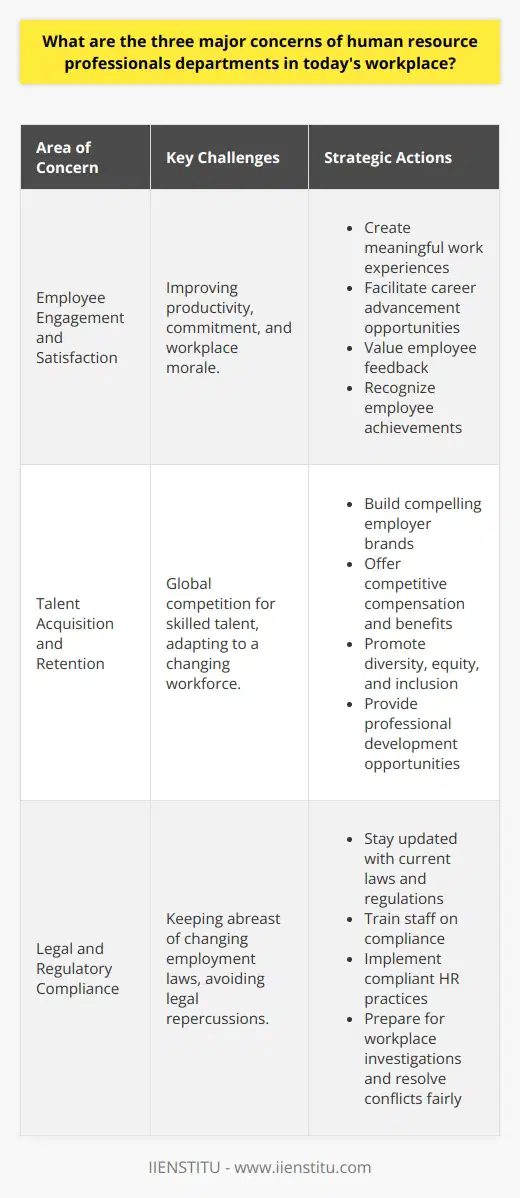
What is the major human resource management challenge faced by managers in today's organizations?
Major Challenge in Human Resource Management
One significant challenge faced by managers in modern organizations is effectively addressing the issue of diversity and inclusion in the workplace. This HR management problem stems from the rapidly changing demographics and increasing complexity of interactions among employees of different generations, genders, ethnicities, and cultural backgrounds. As organizations strive to become more global, this challenge intensifies, and the role of human resource managers becomes critical in ensuring that all employees feel valued, respected, and fairly treated.
Understanding and Addressing Diversity
To manage this challenge successfully, HR managers must possess a strong understanding of the concept of diversity and the different dimensions it covers. This includes not only the visible aspects such as race, age, and gender, but also the invisible aspects such as values, beliefs, and communication styles. By acquiring this knowledge, HR managers can develop comprehensive strategies for promoting inclusion and fostering a positive work environment where diverse perspectives are embraced.
Creating an Inclusive Workplace Culture
A crucial step in addressing diversity and inclusion challenges is the development of a workplace culture that supports these values. HR managers can achieve this by implementing policies and programs that promote open communication, non-discrimination, and equitable treatment of all employees. Additionally, by providing regular training and development opportunities focused on diversity and inclusion, HR managers can enhance employees' awareness, understanding, and competencies in managing cultural differences and creating a bias-free workplace.
Leveraging Diverse Talent and Skills
Effectively managing diversity and inclusion also entails capitalizing on the unique talents, skills, and experiences that diverse employees bring to the organization. HR managers should work towards creating an environment where employees are encouraged to share their diverse perspectives, insights, and ideas. By leveraging these assets, organizations can stimulate innovation, enhance decision-making, and ultimately improve business performance.
Measuring and Evaluating Progress
Lastly, it is important for HR managers to regularly measure and evaluate the effectiveness of their diversity and inclusion efforts. This can be accomplished by monitoring key performance indicators such as employee engagement, retention, and productivity, as well as gathering feedback from employees through surveys and focus groups. These insights can help HR managers identify areas for improvement and adjust their strategies accordingly.
In conclusion, addressing diversity and inclusion represents a major challenge for HR managers in today's organizations. To overcome this challenge, HR managers should focus on understanding the various dimensions of diversity, developing a supportive workplace culture, leveraging diverse talent and skills, and continuously measuring and evaluating progress. By doing so, they can foster a truly inclusive work environment that benefits both employees and the organization.
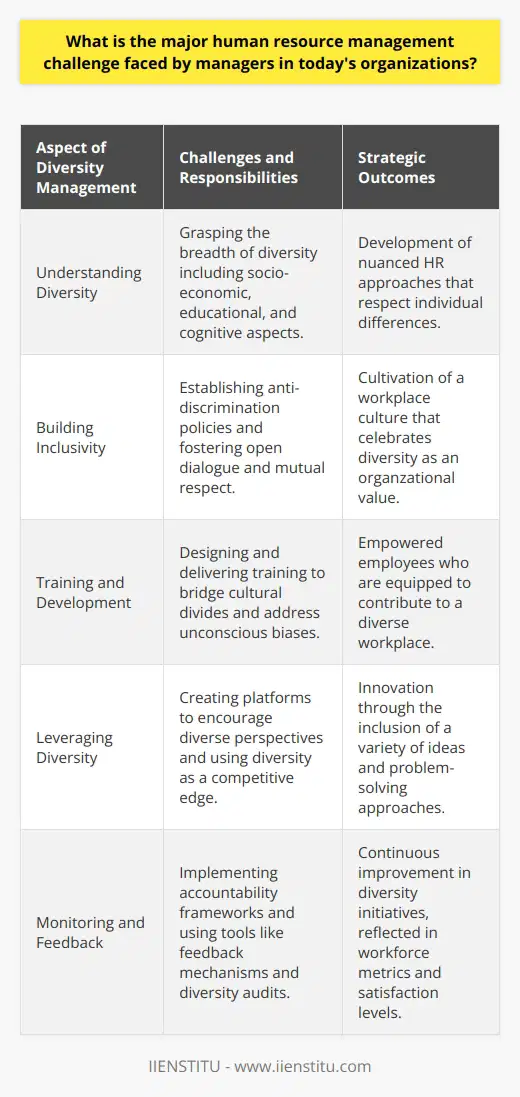
What are the three biggest issues in HR today?
Issue 1: Employee Retention and Engagement
One of the largest challenges HR departments face today is ensuring high levels of employee retention and engagement. With the growing importance of human capital in achieving organizational success, attracting and retaining top talent has become critical. This requires HR professionals to develop strong employer branding, create compelling employee value propositions, and foster inclusive, dynamic workplace cultures.
Issue 2: Adapting to Remote Work and Technological Advancements
Another prominent issue in HR today is the adaptation to remote work and finding suitable solutions for distance collaboration. As the world becomes increasingly connected through technology, businesses must create efficient remote work policies and strategies that suit their employees' work-life balance. Additionally, HR departments need to upskill their workforce to cope with the constant advancement of technology and remain competitive in various industries.
Issue 3: Managing Diversity and Inclusion
Lastly, HR departments grapple with fostering diversity and inclusion within organizations. With an increasingly diverse workforce, HR professionals must develop strategies to address potential conflicts arising from cultural, generational, or behavioral differences. By creating inclusive environments where diverse perspectives are valued, organizations can leverage this diversity to drive innovation and achieve better business outcomes.

What challenges are faced by HRM of today in terms of employee engagement and retention?
Challenges in Employee Engagement
One of the primary challenges faced by human resource management (HRM) in today's business environment is employee engagement. With the rise of remote work and the changing nature of organizational culture, HRM must adapt their strategies to stay connected with employees. Employers now need to foster a company culture that encourages open communication, collaboration, and ongoing learning. Moreover, the role of technology also plays a crucial part in implementing effective engagement practices.
Role of Technology in Engagement
To facilitate employee engagement, HRM should consider utilizing technology solutions such as social platforms and collaboration tools. These tools can help bridge geographical divides and foster a sense of belonging among employees. By adopting advanced technological tools, HRM can also monitor employee performance, gather feedback, and provide support in real-time. However, it is essential to strike the right balance between using technology for engagement and ensuring employee privacy and autonomy.
Retention in a Competitive Job Market
Another significant challenge faced by HRM is employee retention in a highly competitive job market. According to a study, the total cost of losing an employee ranges from 90% to 200% of their annual salary. Therefore, HRM must focus on developing and implementing retention strategies that address the evolving expectations and needs of employees. Providing attractive compensation packages, professional development opportunities, and a supportive work environment are essential components of effective retention strategies.
Personalizing Employee Experience
Today's workforce expects a highly personalized employee experience tailored to individual preferences and goals. HRM must collect data on employee preferences and design customized career paths to cater to their diverse needs. The challenge lies in the ability to collect and interpret employee data while respecting privacy concerns.
Work-Life Balance and Flexibility
A significant challenge in retaining top talent in today's job market is maintaining a healthy work-life balance. HRM plays a vital role in promoting a flexible work environment that accommodates employees' diverse needs. Employees now expect more than just a competitive salary; they value their work-life balance and mental well-being. As a result, HRM should invest in creating an environment that supports employees' career and personal growth alike.
In conclusion, modern HRM faces several challenges in the areas of employee engagement and retention. By addressing these challenges and creating a supportive, inclusive, and flexible work environment, HRM can develop a resilient and loyal workforce that drives organizational success.
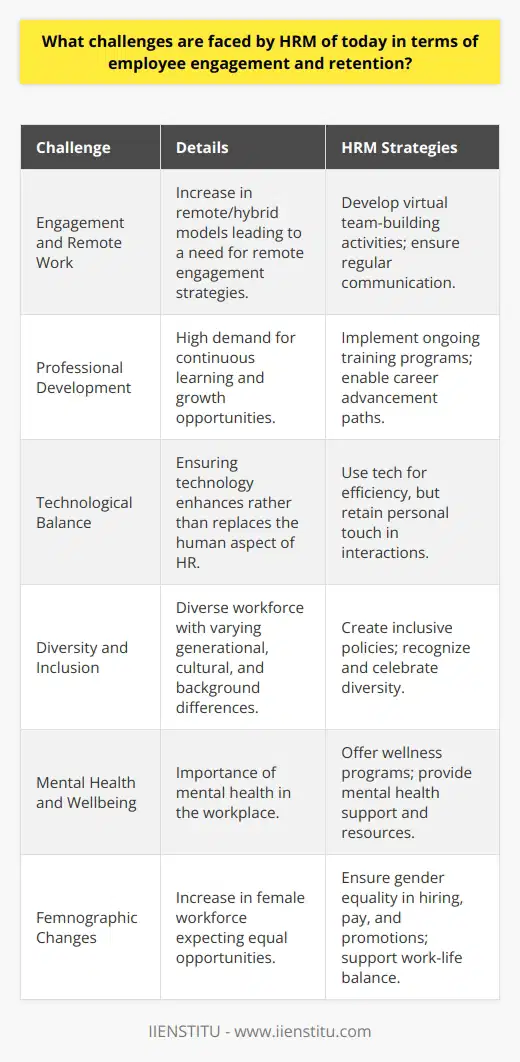
How can HR departments effectively address the issue of the multigenerational workforce in today's organizations?
Understanding the Differences and Commonalities
To effectively address the issue of the multigenerational workforce in today's organizations, Human Resource departments must first understand the unique differences and commonalities among various generations. This insight allows HR professionals to bridge potential gaps in communication, work styles, and expectations.
Promoting Open Communication
Promoting open communication among employees is essential to fostering a positive work environment and alleviating potential discord. HR departments can facilitate this by providing employees with communication guidelines and resources, including conflict resolution and active listening training.
Offering Flexible Work Arrangements
One effective solution for managing a multigenerational workforce is offering flexible work arrangements. By providing employees with the option to choose schedules and work locations that suit their lifestyle and personal obligations, organizations can accommodate and engage employees across different generational lines.
Creating Opportunities for Mentorship and Collaboration
Creating opportunities for mentorship and collaboration within the organization can help bridge the gap between employees of different generations. Implementing mentorship programs, cross-generational project teams, or intergenerational workshops can foster mutual understanding, knowledge exchange, and strengthen relationships among team members.
Tailoring Training and Development Programs
To address potential skill gaps and ensure that all employees are adequately equipped to perform their job responsibilities, HR departments should tailor their training and development programs to respect different learning styles and experiences. Providing options for in-person, online, and peer-to-peer learning opportunities can accommodate the preferences of a diverse workforce.
Recognizing and Valuing Individual Contributions
Recognizing and valuing each individual's unique skills, talents, and contributions in the workplace is crucial to fostering a harmonious and inclusive work environment. HR departments should implement recognition systems that allow each employee to feel valued and respected for their professional accomplishments.
Emphasizing Diversity and Inclusion Initiatives
Lastly, HR departments should emphasize the importance of diversity and inclusion initiatives in their organizations. By fostering an environment that celebrates differences and encourages mutual respect, HR professionals can create a positive, inclusive workplace culture that supports a multigenerational workforce.

What role does HR play in fostering a culture of innovation and adaptability within organizations?
Role of HR in Cultivating Innovation
Human Resources (HR) plays a pivotal role in fostering a culture of innovation and adaptability within organizations. As the department responsible for managing employees, HR is instrumental in creating an environment that encourages creativity, risk-taking, and continuous learning. One way they achieve this is by establishing a robust talent acquisition process, selecting candidates who possess the right mindset and skills necessary to drive innovation.
Staff Development and Training
HR also has a direct impact on enhancing employees' innovative capabilities through staff development and training opportunities. By equipping workers with the latest tools, techniques, and knowledge in their respective fields, HR enables them to stay abreast of emerging trends and adapt to new challenges. Furthermore, offering employees training in transferable skills, such as problem-solving, critical thinking, and effective communication, can empower them to contribute creatively to the organization's strategic objectives.
Employee Engagement and Motivation
In addition, HR is responsible for creating and implementing strategies to maintain high levels of employee engagement and motivation. Engaged employees are more likely to be innovative, as they possess a strong emotional connection to the organization and its goals. Thus, HR must foster a work environment that is conducive to innovative thinking by recognizing and rewarding employees' contributions, providing opportunities for growth, and addressing any organizational barriers that may inhibit creativity.
Promoting Collaboration and Communication
Moreover, HR can encourage innovation by promoting collaboration and open communication among employees. By establishing cross-functional teams, employees from diverse backgrounds and areas of expertise can come together to identify new opportunities and develop innovative solutions. HR also has a duty to cultivate a culture in which all employees feel comfortable sharing their ideas and perspectives, ensuring that everyone's opinions are valued and considered.
Continuous Improvement and Learning
Lastly, HR plays a crucial part in embedding a culture of continuous improvement and learning within the organization. By promoting a growth mindset and supporting employees in their pursuit of additional education or certifications, HR encourages an organizational culture that embraces change and innovation. Through performance management systems and data-driven decision-making, HR can identify workforce trends and areas for development, ensuring the organization is constantly striving towards innovation and adaptability.
In conclusion, HR's role in fostering a culture of innovation and adaptability within organizations cannot be understated. By focusing on talent acquisition, staff development, employee engagement, collaboration, and continuous improvement, HR professionals can create an environment in which innovation and adaptation thrive, ultimately contributing to an organization's long-term success.
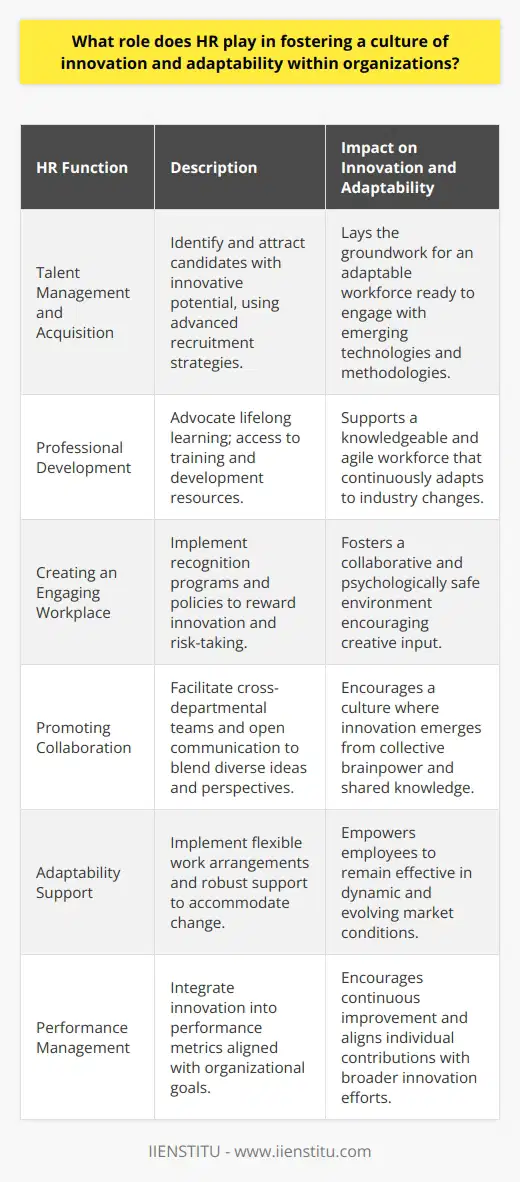
What are the three significant challenges related to remote work that HR professionals need to address?
Challenges in Managing Remote Workforces
**Addressing Technological Disparities**
Remote work has become increasingly popular, and human resources professionals are tasked with managing its nuances. A significant challenge in this domain is bridging the technological disparities that are bound to exist among a diverse workforce. HR professionals must ensure the adequate provision of necessary tools, software, and training, enabling employees to collaborate and perform their tasks efficiently. Moreover, the need to maintain data privacy and cybersecurity requires constant vigilance to protect company information even in remote settings.
**Promoting Communication and Collaboration**
Another challenge related to remote work is promoting effective communication and collaboration among team members. HR professionals should facilitate an environment in which employees feel comfortable utilizing virtual communication channels like video conferences, chats, and project management platforms. Furthermore, addressing issues like time zone differences and cultural sensitivities is essential for fostering smooth collaboration within geographically dispersed teams. In addition, HR professionals need to strike a balance between providing opportunities for staff to engage with each other and avoiding an overload of virtual meetings that may lead to exhaustion and decreased productivity.
**Maintaining Engagement and Well-being**
Lastly, HR professionals face the challenge of maintaining employee engagement and well-being in remote settings. Remote work can lead to feelings of isolation, and HR needs to implement strategies to help maintain employees' mental health and motivation levels. Regular check-ins, virtual team-building activities, and providing access to well-being resources are essential measures for HR to consider in sustaining an engaged and healthy workforce. Moreover, a clear emphasis on work-life balance through tailored policies and setting boundaries on work hours and expectations can contribute significantly to employee satisfaction and an efficient remote work culture.
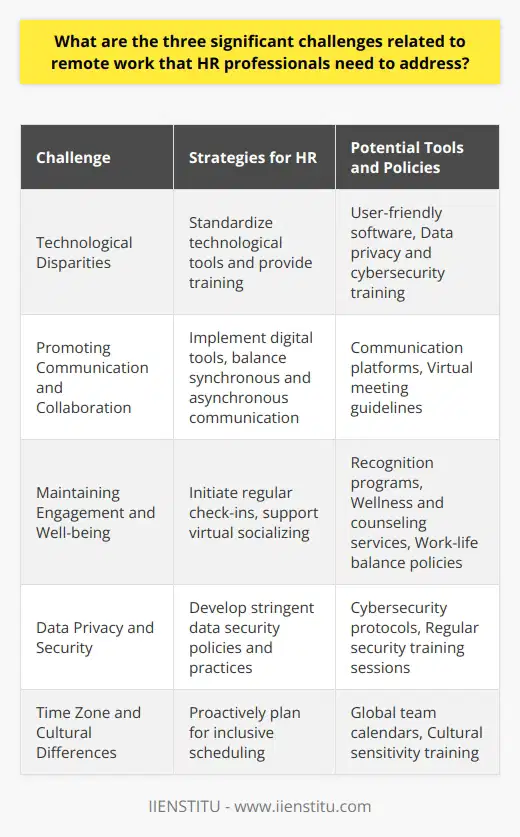
How can HR leadership develop and maintain a strong organizational culture in the face of rapidly changing work environments?
**Understanding Organizational Culture**
Organizational culture refers to the shared values, beliefs, and practices that shape employees' attitudes and behaviors within a company. A strong organizational culture is crucial for ensuring that employees are aligned with the organization's goals, leading to increased productivity and growth. In the face of rapidly changing work environments, HR leadership can develop and maintain a robust organizational culture by focusing on the following strategies.
**Adapting to Change and Innovation**
One of the key challenges that HR leaders face is adapting to new trends and technological advancements. This requires continuous learning and innovation to stay ahead of the curve. HR leaders can foster a culture that embraces change by offering ongoing professional development opportunities, promoting collaboration and knowledge sharing, and encouraging employees to experiment with new approaches.
**Clear Communication**
Clear communication is essential for organizations to stay connected and maintain a positive culture. HR leaders should prioritize two-way communication channels, ensuring that employees have access to information and can voice their concerns or suggestions. This may involve hosting regular town hall meetings, using social media platforms, or establishing communication committees to maintain open dialogue between employees and leadership.
**Employee Engagement and Recognition**
A strong organizational culture is one in which employees feel engaged, valued, and motivated to contribute to the organization's success. HR leaders can achieve this by implementing employee recognition programs, celebrating achievements, and providing praise and feedback regularly. Additionally, involving employees in decision-making processes and incorporating their feedback can empower them to take ownership of their roles within the organization.
**Building Trust**
Trust is a fundamental component of a healthy organizational culture and is vital for maintaining strong relationships among employees and leadership teams. HR leaders can foster trust by being transparent, keeping promises, and behaving ethically and consistently. Providing a safe space for employees to express their opinions and concerns without fear of retaliation is also crucial for building a trusting and open work environment.
**Embracing Diversity and Inclusion**
In today's global workforce, embracing diversity and inclusion is more important than ever. HR leaders should incorporate diversity initiatives into their organizational culture by promoting equity and fairness, as well as by fostering an environment in which individuals of all backgrounds feel welcome and valued. This may involve offering training on unconscious bias and cultural competency, as well as implementing policies that support diverse hiring practices.
By focusing on these strategies, HR leadership can effectively develop and maintain a strong organizational culture in rapidly changing work environments. This, in turn, will contribute to the organization's long-term success, enhance employee satisfaction, and foster a resilient and adaptive workforce.
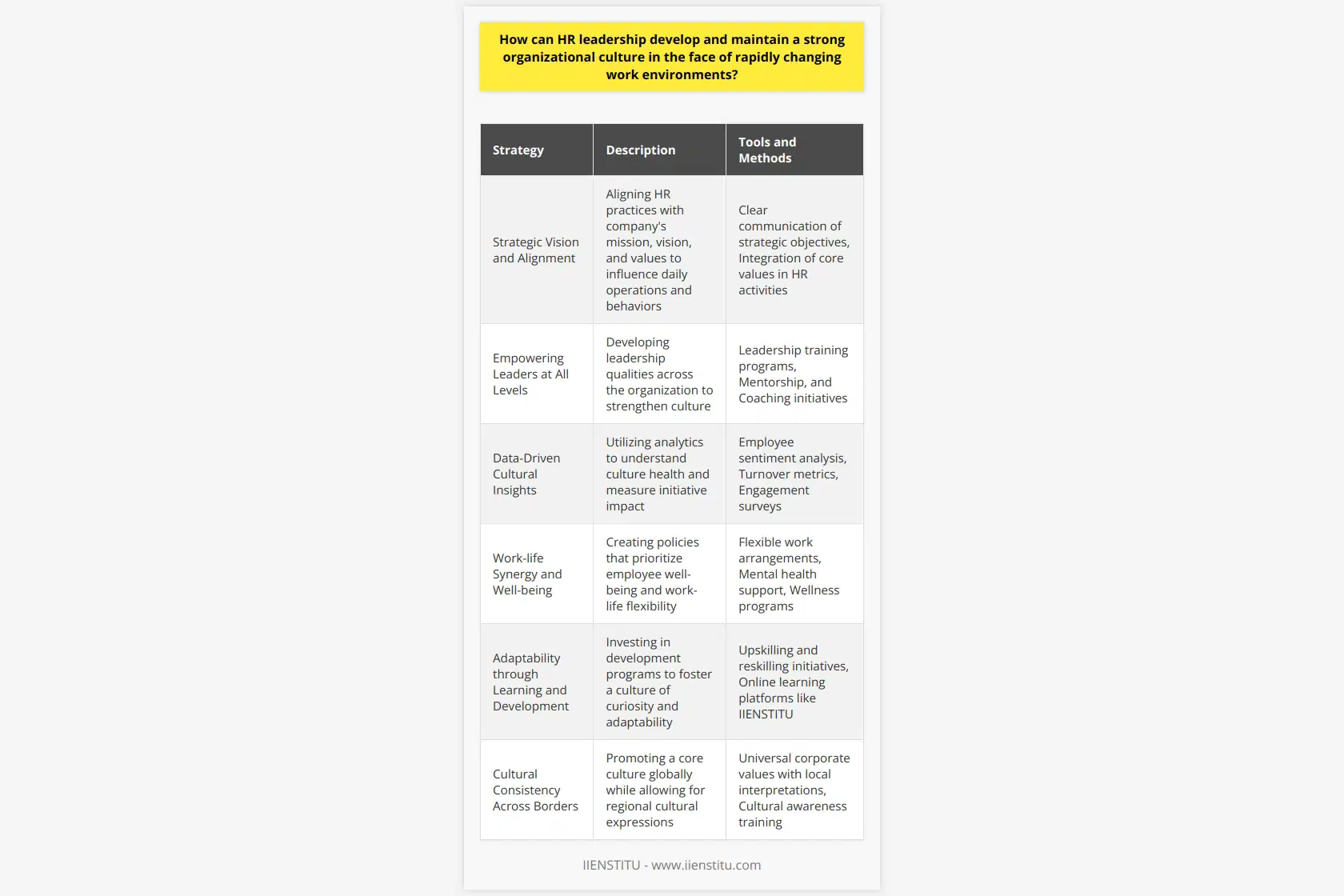
What strategies can HR employ to foster continuous learning and professional development among employees in highly competitive industries?
Establishing a Learning Culture
To foster continuous learning and professional development among employees in highly competitive industries, Human Resources (HR) professionals can prioritize the establishment of a learning culture within the organization. This can be achieved by making learning a core value, encouraging collaboration and knowledge sharing among employees, and promoting self-directed learning initiatives.
Continuous Feedback and Mentoring
Another strategy that HR professionals can employ is implementing continuous feedback and mentoring programs. By creating a company culture that encourages open communication and feedback, employees can constantly strive for improvement, while mentors can offer guidance and support for personal and professional growth. Tailoring mentor-mentee relationships based on employees' needs can result in valuable learning experiences.
Skills Gap Analysis
To guide employees on the necessary professional development, HR should conduct regular skills gap analyses. This involves identifying the required competencies and comparing them to the existing skill sets of the employees. Gap analysis results can be used to develop targeted learning programs to address any shortcomings, ensuring the workforce remains competitive in fast-evolving industries.
Leveraging Technology for Learning
HR can use technology to enhance the learning experience and easily track employees' learning progress. Online courses, webinars, and interactive learning platforms make professional development more accessible, flexible, and personalized. Digital learning tools can also measure employees' engagement and learning retention, helping HR make data-informed decisions about the effectiveness of the chosen learning strategies.
Promoting Internal Mobility
Creating opportunities for internal mobility within an organization can motivate employees to engage in continuous learning and development. HR can champion initiatives that support job rotations, cross-functional projects, and lateral moves, allowing employees to gain experience in different roles and broaden their skillsets. This career progression can inspire employees to stay curious, adaptable, and committed to their professional growth.
In conclusion, HR professionals in highly competitive industries can foster a learning culture, promote continuous feedback and mentoring, conduct skills gap analyses, leverage technology for learning, and encourage internal mobility. By adopting these strategies, organizations can ensure their employees remain competitive and up-to-date with industry trends, ultimately contributing to the organization's ongoing success.
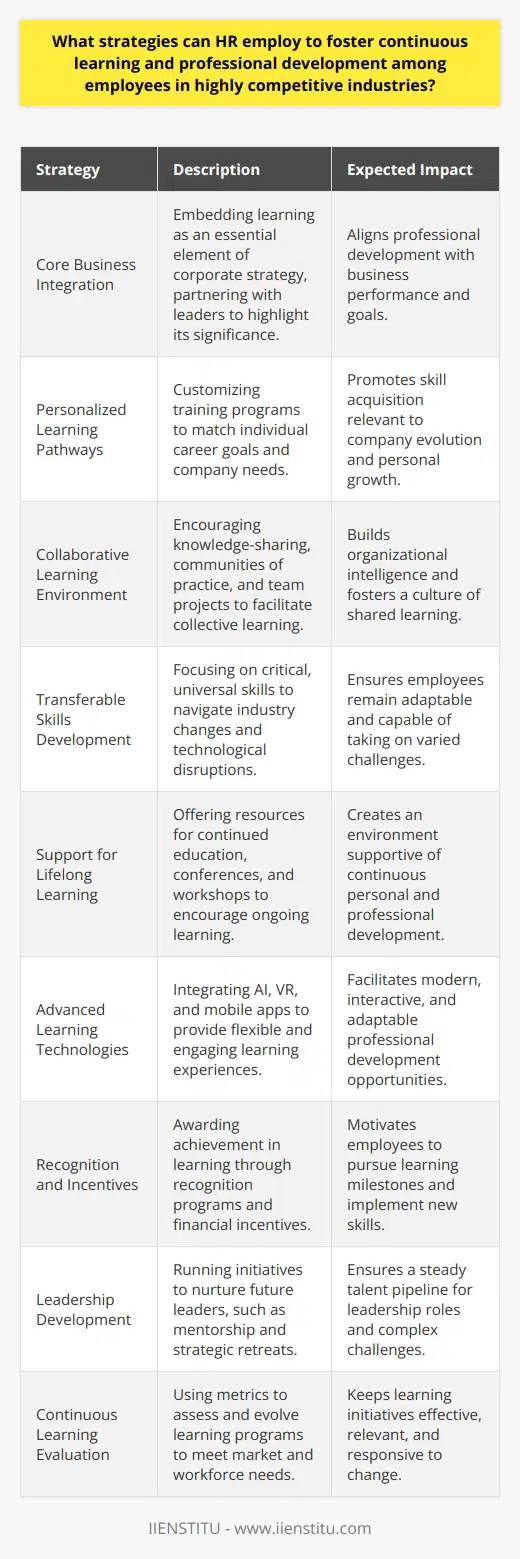
What are the key challenges that human resource management faces with regards to talent acquisition and recruitment in today's highly competitive market?
Challenges in Talent Acquisition and Recruitment
Understanding Labor Market Dynamics
Human resource management faces significant challenges in acquiring and recruiting talent in today's hypercompetitive market. One key issue is keeping abreast of the ever-evolving labor market dynamics. This includes understanding how economic fluctuations, changing industry trends, and shifts in workforce demographics influence talent availability and employee expectations.
Attracting Passive Candidates
Another major challenge is engaging passive candidates—those who are employed but open to new opportunities. These talented individuals often have valuable skills and experiences, making them highly sought-after candidates. HR teams must develop targeted strategies to effectively attract and connect with this group, such as leveraging social media, attending industry events, and developing a strong employer brand.
Adapting to Technological Advancements
The rapid technological advancements are transforming the talent acquisition landscape. Traditional recruitment methods are gradually being replaced or supplemented by cutting-edge tools such as artificial intelligence, applicant tracking systems, and virtual job fairs. HR teams must adapt quickly to ensure they effectively leverage these technologies to streamline the recruitment process and make informed decisions based on data-driven insights.
Managing Remote Recruitment and Onboarding
The rise of remote work further complicates talent acquisition as HR managers must now manage recruitment and onboarding processes for candidates regardless of their geographic location. This entails adjusting existing processes to effectively screen, interview, and evaluate candidates from afar, as well as creating virtual onboarding experiences that facilitate a smooth transition into the company's culture and operations.
Promoting Diversity and Inclusion
In today's global marketplace, fostering a diverse and inclusive workplace is vital for companies seeking to maintain a competitive edge. HR managers must carefully consider various factors such as age, gender, race, and cultural background during talent acquisition to facilitate a rich mix of perspectives and skills. Additionally, HR professionals must address unconscious biases in the recruitment process, create inclusive job advertisements, and offer equitable benefits and career development opportunities.
In conclusion, addressing these key challenges is essential for human resource management professionals seeking to build dynamic, innovative, and inclusive teams. By staying informed about labor market changes, embracing remote recruitment, leveraging technology, and committing to diversity and inclusion, HR teams can navigate the complexities of talent acquisition in today's ultracompetitive landscape.
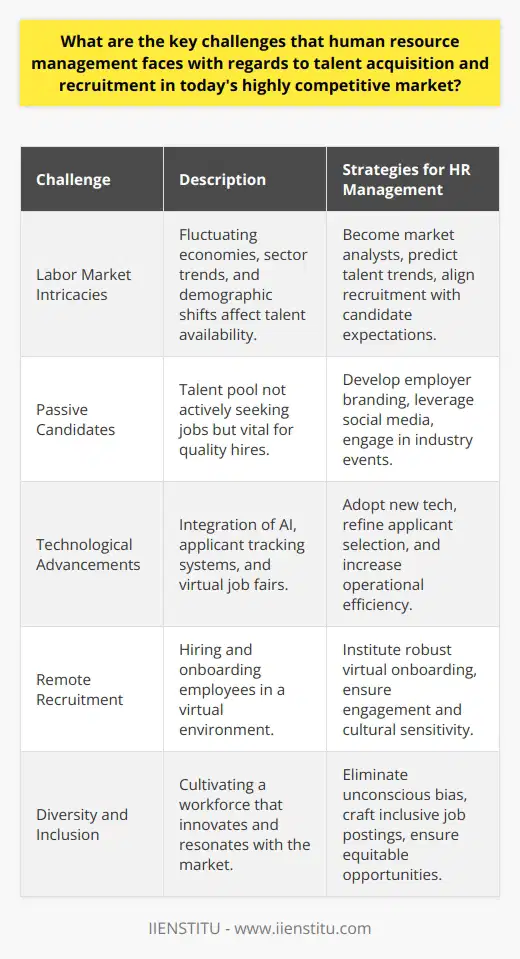
How can HR professionals balance the needs for flexibility and efficiency in the workforce while ensuring job security and employee satisfaction?
Balancing Flexibility and Efficiency
To create an effective workforce, HR professionals must strike a balance between the need for flexibility and efficiency while ensuring job security and employee satisfaction. This can be achieved by implementing a range of strategies and policies catered to the unique requirements of the company and the individual worker.
Communication and Collaboration
One critical aspect of maintaining a dynamic workforce is the encouragement and facilitation of open communication and collaboration between employees and management. This not only helps to identify and resolve issues as they emerge, but it also fosters a sense of trust and cohesiveness, ultimately contributing to increased job satisfaction.
Continuous Learning and Development
In addition to effective communication, supporting continuous learning and development promotes a culture of adaptability, critical to maintaining efficiency and flexibility. By offering employees opportunities to enhance their skills and abilities, HR professionals can help establish a growth mindset within the organization.
Adaptability of Work Arrangements
Embracing technological advances and innovative work arrangements can contribute to greater flexibility and job satisfaction among employees. These may include remote work options or alternative scheduling to accommodate individual needs, allowing employees a sense of autonomy and control over their work-life balance while also meeting organizational demands.
Job Security and Employee Engagement
To maintain job security amidst a flexible and ever-changing workforce, HR professionals must prioritize employee retention and engagement. Providing growth opportunities, competitive compensation, and comprehensive benefits packages, as well as demonstrating a genuine regard for employee well-being, can significantly impact overall satisfaction and commitment to the organization.
Performance Management
Regularly assessing and optimizing employee performance empowers HR professionals to identify areas of improvement and align individual efforts with organizational goals effectively. By fostering a culture of feedback and accountability, employees are incentivized to strive towards a high level of productivity and satisfaction.
In conclusion, striking the right balance between flexibility, efficiency, job security, and employee satisfaction requires a multifaceted approach from HR professionals. By committing to open communication, continuous learning, adaptable work arrangements, employee engagement, and performance management, organizations can create a thriving work environment that promotes organizational success while catering to the individual needs and well-being of employees.
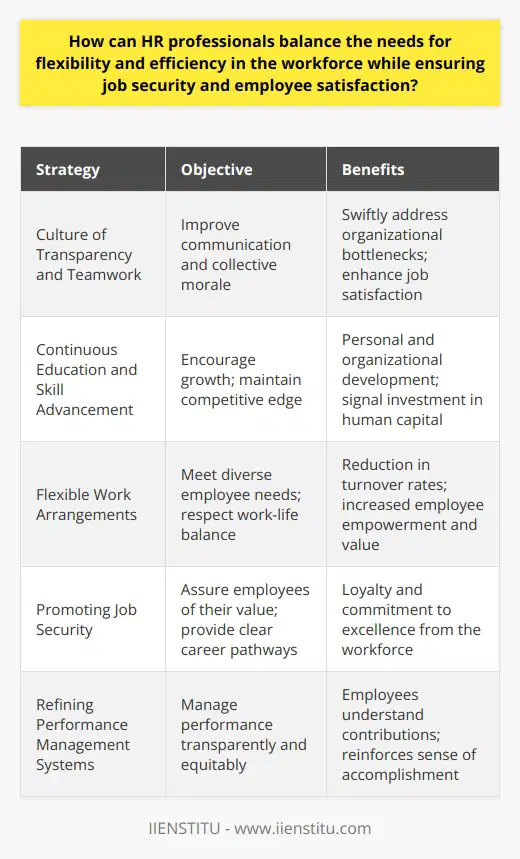
In the era of digital transformation and automation, what essential steps should HR departments take to future-proof their organizations and employees' skills?
Developing a Proactive Strategy
In the era of digital transformation and automation, HR departments must develop proactive strategies to future-proof their organizations and employees' skills. One essential step is embracing technology itself by integrating digital tools and systems that facilitate efficient HR operations and employee development programs.
Continuous Learning and Skill Development
HR departments should invest in continuous learning and skill development opportunities for employees. Providing access to online training courses, workshops, and seminars can empower workers to expand their knowledge and stay competitive in the digital age. Collaborating with educational institutions to create customized training programs can further enhance the workforce's adaptability in response to evolving market demands.
Mentoring and Knowledge Transfer
Structured mentorship programs can promote knowledge transfer within the organization, encouraging experienced employees to share their expertise with younger team members. This approach fosters a learning culture, allowing for faster adaptation to technological advancements and ensuring the organization maintains a high level of productivity and innovation.
Emphasizing Emotional Intelligence
As automation handles repetitive tasks, the demand for attributes like emotional intelligence, communication skills, and critical thinking increases. HR departments should identify and hone these essential soft skills in employees, as they become indispensable for effective collaboration and performance in the digital era.
Enhancing Worker Mobility
Increased worker mobility enables organizations to respond swiftly to market changes by rapidly assimilating new skills and knowledge. HR departments should encourage cross-functional transfers, job rotations, and temporary assignments to facilitate skill diversification and promote a well-rounded employee base.
Inclusive Workforce Planning
HR should devise inclusive workforce planning that anticipates the impact of digital transformation on different roles and functions. This approach assists in identifying the skills required for future jobs and guides talent development initiatives accordingly.
Prioritizing Data Security
Automation and digital reliance come with data security concerns. HR departments must ensure employees receive proper training on responsible data handling, while also enforcing robust policies and procedures for information protection.
In conclusion, thorough integration of digital technology, continuous learning, skill development, mentoring, soft skills emphasis, worker mobility, inclusive workforce planning, and prioritizing data security are crucial for HR departments seeking to future-proof their organizations and employees' skills during this era of digital transformation and automation. These initiatives will ultimately help organizations stay competitive and adapt to rapidly evolving market demands.
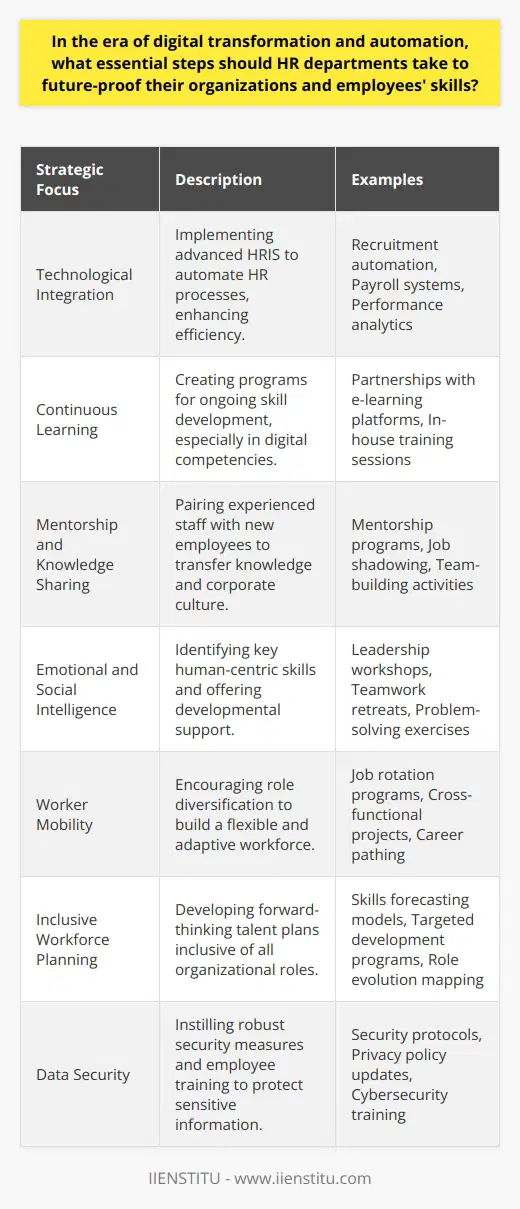
What are the key human resource challenges for today's managers in maintaining a healthy work-life balance for employees?
Understanding Work-Life Balance
Today's managers face significant human resource challenges in maintaining work-life balance for their employees. One key challenge is employee burnout. Overworking leading to physical and psychological exhaustion is common in fast-paced environments.
Evolving Employee Expectations
Moreover, managers grapple with evolving expectations of the workforce. Workers today, especially millennials and generation Z, prioritize work-life balance over money. They demand flexible working hours, remote work options, and personal time for relaxation or pursuing hobbies.
Technological Interferences
Technology creates other obstacles. The rise of digital communication platforms has blurred the line between work and personal time. Employees often find it difficult to unplug from work, increasing stress levels and detracting from personal time.
Effective Communication and Expectations Setting
Ensuring effective communication and setting realistic expectations is another challenge. Managers not clearly communicating project deadlines and expected work hours often burden employees causing work-life imbalance.
Cultural Shifts
Finally, societal and organizational culture can hinder work-life balance initiatives. Organizations with a work culture that rewards overwork or lacks supportive policies for employee wellbeing struggle to maintain a healthy work-life balance for workers.
In conclusion, to maintain a healthy work-life balance for employees, managers must address the prevailing work culture, technology misuse, evolving employee expectations, and the risk of burnout. Effective communication and supportive policies can enable managers to meet these challenges, improving employee satisfaction and overall productivity.
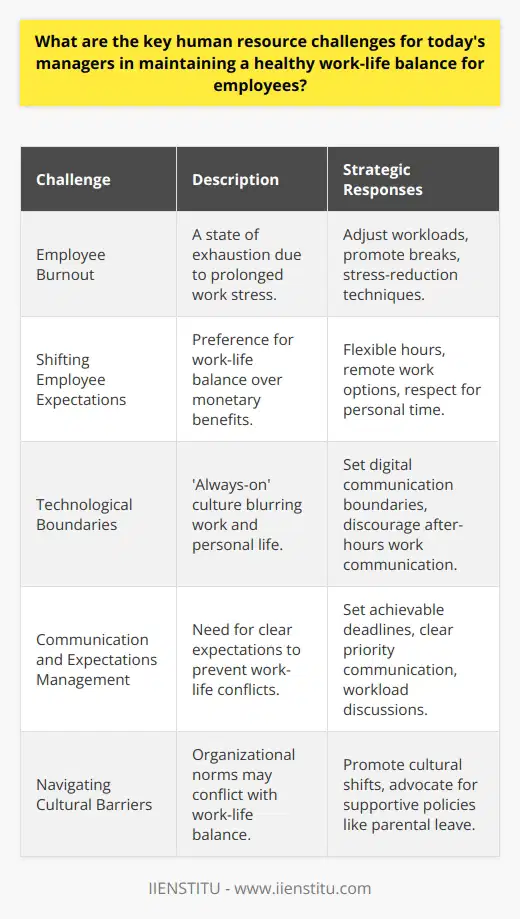
How do HR managers overcome challenges related to effectively managing a remote or hybrid workforce?
Adopting Technological Tools
HR managers overcome challenges linked to managing remote or hybrid workforces primarily through the adoption of technological tools. Technological platforms offer cohesive communication channels. They ensure smooth interaction among team members, enhancing collective performance.
Emphasizing Clear Communication
Furthermore, clear communication is fundamental to overcome such challenges. HR managers need to convey information and expectations precisely. This initiative reduces misunderstandings and boosts productivity.
Fostering a Culture of Trust
Building a culture of trust is also crucial. HR managers need to trust their employees to complete their tasks, even when working remotely. Employees who feel trusted likely show higher levels of job satisfaction and motivation.
Promoting Work-Life Balance
Promoting work-life balance is an effective measure as well. HR managers need to respect employees' personal time. Striking the right balance usually results in improved job efficiency and employee well-being.
Providing Regular Feedback
Providing regular feedback can make a significant difference too. Employees often seek constructive critique to improve their performance. Thus, the practice of giving regular feedback enables employees to grow and adapt promptly to a remote or hybrid working environment.
Implementing Training Programs
Finally, implementing training programs can help. These programs can guide employees on how to navigate through the challenges of remote or hybrid work environments. Proper training equips the workforce with necessary skills and promotes understanding and efficiency.
In conclusion, HR managers deal with challenges related to managing remote or hybrid teams by utilizing various strategies. These include employing technology, fostering effective communication, trust-building, promoting work-life balance, regular feedback, and effective training programs.
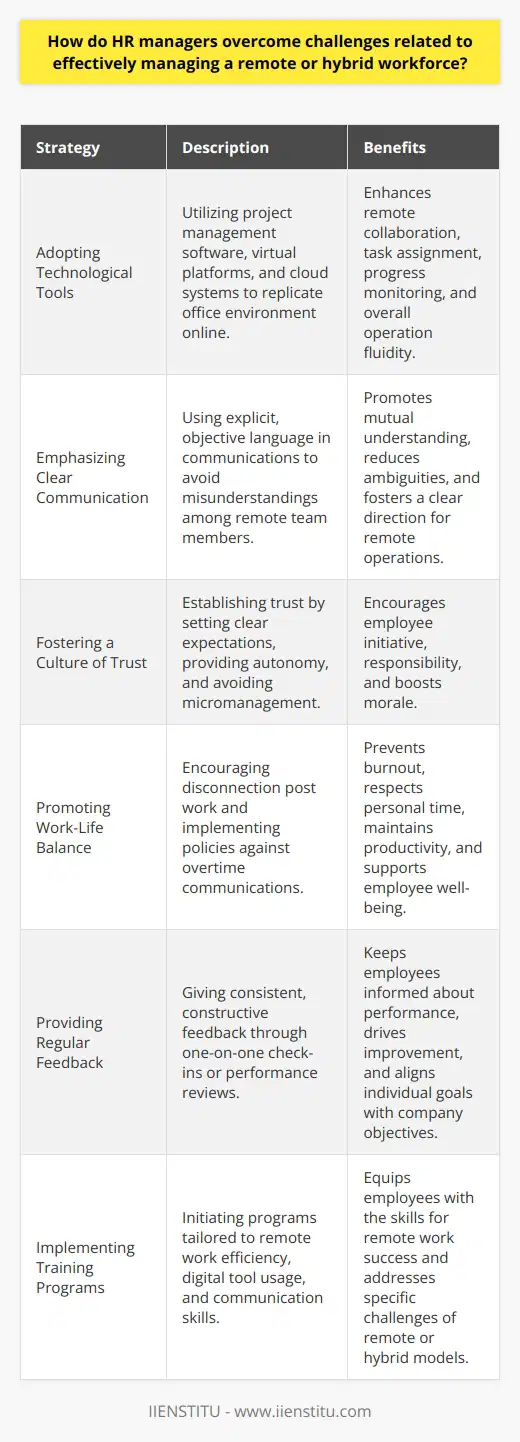
In the context of increasing global competition and economic uncertainty, what strategies can HR professionals implement to attract and retain top talent while controlling labor costs?
Strategic Recruitment Policies
HR professionals can develop strategic recruitment policies to attract top talent. Focusing on a strong employer brand helps draw in potential hires. Enhancing company reputation and corporate culture plays a significant role in this strategy, making the organization more appealing to top talent.
Performance-based Compensation Packages
To retain top talent, HR can implement performance-based compensation packages. Such packages should offer competitive and fair pay. By tying remuneration to the outcomes achieved, businesses can incentivize high performance, thereby controlling labor costs effectively.
Professional Development Opportunities
Offering professional development opportunities is another effective strategy for talent retention. Continuous training and learning experiences foster employee growth, enhancing their value to the organization. Additionally, it serves as a motivational driver, encouraging employees to achieve their full potential.
Workplace Flexibility
With the evolving work landscape, flexi-work arrangements can be a defining factor in talent recruitment and retention. Such policies cater to work-life balance, appealing particularly to the contemporary workforce. This not only attracts new hires but also aids in retaining current employees.
Focus on Employee Well-being
Furthermore, an emphasis on employee well-being can also differentiate an organization. Employees value health, stress management, and wellness programs. Treating employees well goes a long way in creating a loyal workforce, reducing turnover and associated recruitment costs.
In conclusion, HR professionals must balance attracting and retaining top talent with controlling labor costs. Mass recruitment and retention strategies are not cost-effective. Instead, a more strategic approach involving employer branding, performance-based compensation, professional development, flexi-work, and focus on employee well-being can yield better results.
